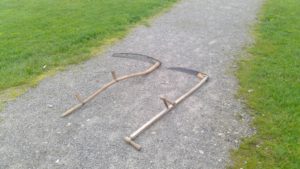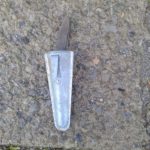
By Gabe Ross, Farm Manager
Have you ever wondered what it would be like to mow the grass without any noise and exhaust fumes? Even electric mowers are noisy. The solution to this problem doesn’t come from looking into the future, it comes from the past. The simple scythe has been used to cut grass as far back as the Roman empire. Before the onset of the sickle bar mower in the mid-19th century it was the best way to harvest grass for hay (at that time lawn mowing didn’t factor into many equations). The scythe is still used in many parts of the world and is gaining popularity again in the United States.
Scythes have some interesting terminology that go along with them. The long handle that holds the blade is called a snath and the two handles the mower grips are called nibs. And yes, it is called mowing even when done with a scythe. The word mow, as in to mow the grass, is related to mow, as in a hay-mow, even though they are pronounced differently (mow in hay-mow rhymes with “cow”).
There are two common types of scythes, the English and the European, or Austrian. The English scythe is the scythe that you see hanging in barns and on the walls of your local Cracker Barrel restaurant. It has a steam bent snath with two, often adjustable nibs. The steel blade is much heavier and harder than that of the European Scythe and is sharpened on a whetstone wheel. European scythes have a straight snath and a much softer blade. These Scythes are sharpened, believe it or not, with a hammer, a process called peening. The scythe is laid on a special anvil and a cross peen hammer is used to draw or peen the metal out to a thin edge. This type of soft blade is useful because if a rock is hit while mowing the dent in the blade can be peened out. After peening, a scythe stone is used to hone the blade. The scythe stone is stored in a horn on the mowers belt that is about half full of water to keep the stone wet. These used to be made from a cow horn or wood but today are often galvanized steel. The scythe stone itself is often a piece of rock cut into the right shape or can be a synthetic stone. While the two types have advantages and dis-advantages, when sharp, they both perform quite well, and it often comes down to the preference of the mower.

By the 1930s, grain binders, sickle bar mowers, and even combines had taken the place of the scythe on most Ohio farms. Scythes were still used for trimming weeds and for small mowing jobs around the farm. String trimmers didn’t come around until the early 1970s. In some applications the scythe is still a useful tool. Here at Gallant farm we use a scythe to harvest green chop, which is just grass and clover fed to the sheep to supplement grazing. Last year this helped us conserve hay by cutting stockpiled fescue well into December. Come visit us at Gallant Farm and learn to use this amazing piece of agricultural history. Watch the Preservation parks Facebook page in June for dates and times when we will be making hay.






